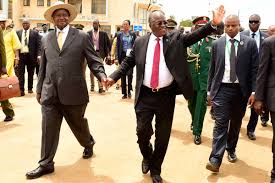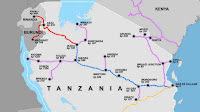Politicians in east Africa lead in scandalmongering
 |
| Presidents: Magufuli and Museveni: Friendship or deception? |
Politicians in East Africa, lead in scandal Mongering, we can report.
They willfully distort facts to support fake corruption claims. This is a malicious bid to sabotage government projects; bully “stubborn Officials” into submission and/or get contracts for their cronies or for themselves, we can report.
A survey of the most berated projects between 2015 and 2017 has established that the corruption claims were fake, driven by malice and selfish political goals.
In all cases surveyed, the allegations of corruption provided no concrete evidence and no one was ever prosecuted. Instead, technical reviews established cases of malice and vendetta. There was no evidence of sincerity on the part of the critics either. The alleged cases were prosecuted in Press conferences and public rallies.
Four issues emerged in our survey to explain the fake reports: Protection of personal interests threatened by certain developments; tender brokerage, witch hunt, and Propaganda aimed at sabotaging the projects for political gain. In some cases, it was a combination of all four.
To achieve their nefarious goals, the scandal-mongers alleged rip-off in the projects. Among the leading scandal mongers in the region are President John Pombe Magufuli of Tanzania, Raila Amolo Odinga, the veteran oppositionist in Kenya, and the Ugandan Parliament.
The three individuals and institutions publicly made claims of corrupt deals which turned out false. Among these is the cost of infrastructure projects such as the Standard Gauge Railway from Mombasa to Kampala, highways, water dams, and Oil Pipelines. All allegations were designed to sabotage the projects for political and malicious goals.
In 2016, Kenya’s opposition doyen claimed that half- of the US$2 billion raised in a Eurobond borrowing in 2014 was stolen. It was even alleged that the Federal Reserve, the Central bank of the US, helped hide the money. An investigation established that the money was transferred to the Central Bank of Kenya’s account at the Fed.
Even the Controller and Auditor General undertook a mission to the Fed and is yet to publish his findings more than a year later. Investigations established Zero evidence of theft and the file closed. It was noted that the Eurobond, floated in the Irish stock exchange on June 14, 2014, hit the market on the same day that the Somalia based terror group, Al-shabaab, slaughtered over 100 people in Mpeketoni, in Lamu County, Kenya.
Analysts then suspected that the terror attack was designed to sabotage the Eurobond, by projecting Kenya as insecure. The market oversubscribed the bond by 400 percent.
In Uganda, a parliamentary Committee almost grounded the Standard Gauge Railway project by alleging massive rip off. The Parliamentary Committee on Infrastructure, headed by Dennis Sabiti, wrote a malicious report about Uganda’s SGR. The committee alleged that the $2.3 billion tab for the 273 Km Malaba-Kampala section was a rip-off citing Ethiopia which had completed a 760Km line of just about the same amount.
The Tanzanian president, relying on this report, tried to talk the Ugandan President into re-routing the line from Mombasa to Dar-Es-Salaam through the Central Corridor. Magufuli willfully misled the Ugandan President, alleging that the Northern Corridor SGR was a rip-off as the Tanzanian line was cheaper.
This was in a bid to shore up his own line which is deemed unviable. The region to be served cannot generate sufficient freight tonnage to make the line viable. All countries, to be served, Including Tanzania, Burundi and Rwanda can generate only 8.5 million tones in line whose capacity is 17 million tones a year. Uganda’s freight, on the other hand, is 10 million tones a year, a mouthwatering prospect for the DIKKM.
 |
| Raila Odinga: Leading scandal Monger in kenya |
Picking the cue from the President, the contractors building the Tanzanian line- Turkey's Yapi Merkezi Insaat VE Sanayi As and Portugal's Mota-Engil Engenharia- also tried to get Museveni to give them the deal.
However, evidence emerged of vendetta on the part of Mr. Sabiti. The Politicians had an ax to grind with the Works Permanent Secretary. The PS has refused to fund the Parliamentary Committee’s two- week benchmarking trip to Ethiopia, Kenya, and China, irking the Politicians who paid him back by bad mouthing the project.
Further, it emerged, the Northern Corridor Railway is superior to Tanzanian and Ethiopian lines. It also emerged that, no matter who constructs the line, the cost cannot be lower given the Ugandan terrain. The Tanzanian and Ethiopian lines were cheaper because apart from being inferior, they also were upgrades of an old line, were constructed on relatively flat terrain, and had fewer or no bridges.
Bridges form 30 percent of the cost of constructing a Railway line and Uganda will have 27 Km of bridges. Those findings discredited the Parliamentary report and President Museveni stuck to the Kenyan link.
The same malicious tongue lashing was evident in the 51 Kilometre Kampala-Entebbe expressway. The road was branded the most expensive highway in the world by Uganda’s Parliamentary committee on statutory Enterprises, COSASE. The Committee wondered how a kilometer of Road cost $9.3 million and ordered the review of the same.
The expressway is a four-lane expressway that boasts 19 fly-overs and bridges measuring 2.77 Kilometres. It also boasts of the 1.4-kilometer Nambigirwa Bridge, the longest four-lane bridge in Uganda and East Africa. The US$497 million expressway, is thus 206 kilometres of road on a 51 kilometre stretch. Consequently, its cost is US$2.4 million per kilometer which is the standard price for such roads elsewhere.
In Kenya, the Standard Gauge Railway line from Mombasa to Nairobi faced severe criticism regarding its cost. Some politicians even suggested that US$1 billion was stolen from the project thus inflating its cost. It emerged later that the politicians, all members of the opposition party, ODM, were funded by a tenderpreneur who lost the bid to get his chosen contractors to build the line on a PPP basis.
 |
| Anne Waiguru: Lost her job to scandalmongering |
The same tenderprenuer was also behind the Eurobond saga, paying the same politicians to dispense fake reports. He was also behind the NYS scandal which alleged massive theft of public funds. However, the parliamentary Public Account Committee could not even put a finger on the amount stolen and the culprits, calling instead for the investigative agencies to investigate an Officer.
Emerging evidence suggests that the committee, headed by Opposition MPs, was working to cover-up the lies spread by their leader. The Party itself leads a corruption tag team in Kenya.
The SGR line is already complete and operational. It has lived to its expectations of cutting travel time between Nairobi and Mombasa to four hours for passenger trains and 8 hours for the freight train.
However, freight truck owners, some of them, politicians, are crying for their business is at stake: One fully loaded train puts 300 trucks off-the-road while a fully loaded 20-car passenger train puts 56 buses off the road.
The lesson from our research is: the media was taken for a ride as it parroted the allegations without interrogating them. They never questioned the experts, that is, the people implementing the project and asking to see the design documents and the contract agreements.
Short of this, the media helps politicians and corrupt businessmen to sabotage projects that would otherwise benefit our countries. We help condemn our countries- and ourselves - into a state of perpetual under development in the name of fighting corruption.



Comments
Post a Comment